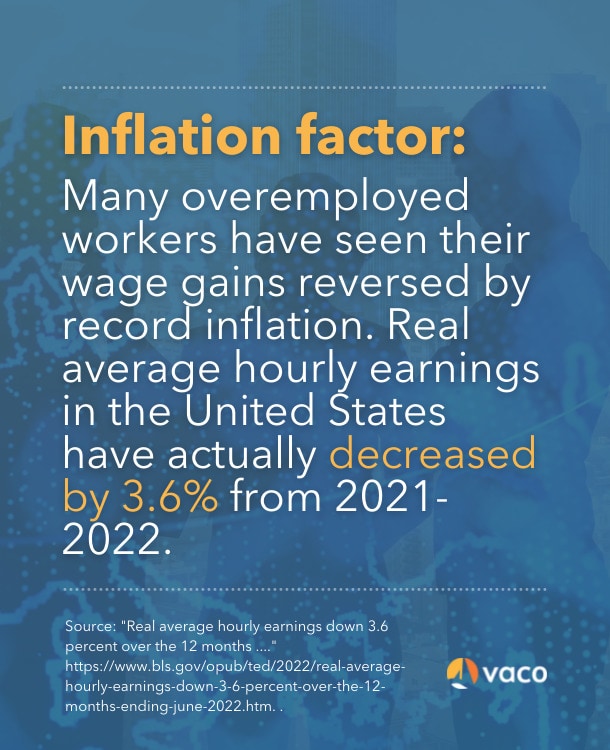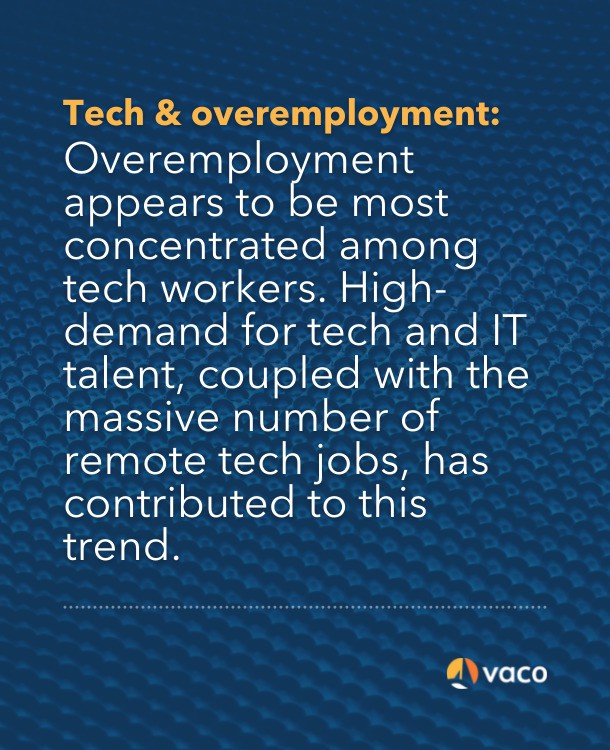Side hustles are an open secret in most industries. The freelancing world has always been populated with people who hold full-time roles but want to make extra money on the side.
In the wake of the pandemic, the side hustle has become more than an after-hours hobby or weekend pursuit. Thousands of workers are taking advantage of the hot job market, skyrocketing demand for their skills, and abundant remote jobs by simultaneously taking on multiple full-time roles. This emerging trend is known as overemployment, and companies are becoming concerned about its potential impacts on their organizations.
Many workers emerged from the pandemic feeling disillusioned by layoffs, pay cuts, and poor treatment by their employers. As sky-high inflation erases wage gains and cost-of-living increases place financial stress on employees at all levels, thousands of workers are choosing a risky solution: covertly working multiple full-time, remote jobs. It’s a career choice that requires secrecy, careful planning, and the ability to keep a low profile at all times. It also requires the ability to remain detached and systematic about how much time and effort is put into each job.
While many people view overemployment as disingenuous and unethical, its advocates view it as a way for employees to exert control over their financial and professional lives.
For employers, it raises questions about policies on moonlighting and how to address the very real reasons employees choose this path to begin with.
A growing trend in the post-pandemic work world
The overemployment movement—a growing subset of non-contingent, higher-income people secretly working two full-time jobs—has thrived in the post-pandemic world for a number of reasons. Chief among them is the widespread growth of remote and hybrid work. Being able to work from home has allowed many people to enjoy more flexibility in their jobs and achieve better work/life balance. For others, the lack of oversight and relative anonymity of working remotely has opened the door to doubling or tripling their annual incomes by taking on multiple full-time roles—and working them simultaneously.

Growing enthusiasm for the overemployment trend has given rise to multiple online communities—Discord servers, Reddit threads, and the eponymous website, overemployed.com—where members share their experiences and offer advice for successfully juggling the intricacies of the overemployed life. Users nearly always post anonymously; in fact, one of the most important aspects of successful overemployment is to attract as little attention as possible.
Drawing too much attention—being too good at one of your jobs, for instance—opens the door to increased responsibilities and more meetings. Either occurrence can spell disaster for the overemployed.
Despite the risks, many workers feel that the financial benefits are worth the trouble.
Why overemployment is an attractive option for many workers
For the vast majority of overemployed people, money is the motivating factor.
It’s easy to forget, amid the news stories about record job openings and rising salaries, that inflation has all but wiped out real wage gains over the past year. U.S. average hourly earnings are down 3.6% since July 2021. 45 U.S. states have experienced double-digit rent increases since the start of the pandemic. The average cost of food in the U.S. has soared by 10.4% since 2021. When gasoline prices peaked in mid-summer 2022, the cost per gallon was 59% higher than it had been just one year earlier.
As whispers of a potential recession swirl, many workers are concerned about another round of layoffs, furloughs and reduced hours. They see overemployment as a way to protect themselves from the financial strife of another economic downturn.
Overemployment in tech
According to Resume Builder, an estimated 37% of remote workers have a second full-time job. While this percentage reflects workers from multiple industries, the tech sector is by far the most closely tied to the overemployment conversation. In fact, overemployed.com focuses explicitly on tech and IT jobs, and most posters on the site are (over)employed in tech roles.
So why is tech so heavily represented in the overemployment world?
High demand for workers, low supply of job seekers
Tech professionals are in extremely high demand in the current labor market, and that demand is still growing. The supply of qualified tech professionals lags far behind.
It is estimated that there will be a global shortage of over four million software developers by 2025; the number of unfilled cybersecurity jobs grew by 350% between 2013 and 2021. Data scientists, machine learning engineers, cloud architects—all of these professionals have numerous job opportunities at their fingertips at any given time. Competition among hiring companies to acquire their skills have driven tech salaries higher than they’ve ever been.

The high demand for tech talent has pushed millions of organizations to change the way they recruit and hire for tech and IT roles. It has also forced them to adopt more flexible policies on when and how their tech teams do their jobs.
Remote roles are plentiful in tech
The tech sector is a longtime proponent of remote work. After the pandemic, millions of new tech roles are exclusively remote.
In 2021 data from the Bureau of Labor Statistics, nearly 50% of employees in computer and mathematical occupations reported being able to telework. In a 2022 survey of nearly 60,000 software developers, 43% reported being fully remote. Most tech workers say they do not want to return to the office full-time.
In response, desperate hiring companies have made their new tech positions fully remote with flexible hours. They’ve opened their talent pools to candidates across the country and relaxed requirements for four-year degrees or years of experience. Instead, they’re emphasizing skills and competencies. This has created a slew of high-paying jobs that are open to a wider number of tech workers.
The nature of tech and IT work
Finally, many tech jobs tend to be task-based, prioritizing output over cultural alignment or interpersonal engagement. This theoretically makes it easier for tech workers to maintain dual-employment and elude notice—as long as they deliver completed work, on time and to their managers’ satisfaction.
Read more: Where has all the talent gone?
Concerns for employers—and how they can respond
There are a few reasons employers should be concerned about their team members working multiple full-time jobs simultaneously:
- Revealing and misusing confidential information
- Misusing intellectual property
- Providing outside parties with access to software, company data and client information
- Degradation of team morale and company culture
- Decreased focus and attention to detail when completing work
Companies can respond to these risks by updating their policies on employee moonlighting and use of intellectual property. Moonlighting laws differ by state, so companies should consult with their legal teams before updating their own policies on how and when employees can accept additional employment.
It is crucial for organizations to be consistent in how they apply, communicate and document their policies on employee moonlighting. Overlooking one employee’s transgressions while issuing disciplinary action against another could lead to a legitimate legal claim.
Companies should also take steps to ensure that access to their data is only provided to employees who need it to do their jobs.
Addressing overemployment in your organization
The most important way that companies can reduce overemployment among their workers is to address the reasons they’re working multiple jobs in the first place:
- Assess pay and benefits packages to ensure that employee salaries are competitive in the current market
- Assess the performance and impact of managers in departments where overemployment is common
- Create clear roadmaps for employee career development
- Improve opportunities for skill development and training
- Explore ways to improve team-building and engagement for remote workers
While updated policies and data protection are important tactics for quelling risks posed by overemployed team members, it is equally important for companies to focus on building a connected and engaged workplace culture—one that meets the unique needs of remote teams and managers.
The hiring and recruiting experts at Vaco help companies of all sizes find top talent for a variety of roles, whether they’re remote, hybrid, or on-site. Learn more about our expertise or reach out to our talent specialists to see how we can transform your hiring efforts.

Interested in learning more?
Subscribe today to stay informed and get regular updates from Highspring









